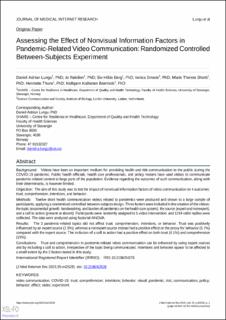| dc.contributor.author | Lungu, Daniel Adrian | |
| dc.contributor.author | Røislien, Jo | |
| dc.contributor.author | Berg, Siv Hilde | |
| dc.contributor.author | Smeets, Ionica | |
| dc.contributor.author | Shortt, Marie Therese | |
| dc.contributor.author | Thune, Henriette | |
| dc.contributor.author | Brønnick, Kolbjørn Kallesten | |
| dc.date.accessioned | 2023-08-28T08:25:35Z | |
| dc.date.available | 2023-08-28T08:25:35Z | |
| dc.date.created | 2023-08-25T10:41:13Z | |
| dc.date.issued | 2023-08 | |
| dc.identifier.citation | Lungu, D.A., Røislien, J., Berg, S.H., Smeets, I., Shortt, M.T., Thune, H., Brønnick,K.K. (2023) Assessing the Effect of Nonvisual Information Factors in Pandemic-Related Video Communication: Randomized Controlled Between-Subjects Experiment. Journal of Medical Internet Research, 25:e42528 | en_US |
| dc.identifier.issn | 1438-8871 | |
| dc.identifier.uri | https://hdl.handle.net/11250/3085929 | |
| dc.description.abstract | Background:
Videos have been an important medium for providing health and risk communication to the public during the COVID-19 pandemic. Public health officials, health care professionals, and policy makers have used videos to communicate pandemic-related content to large parts of the population. Evidence regarding the outcomes of such communication, along with their determinants, is however limited.
Objective:
The aim of this study was to test the impact of nonvisual information factors of video communication on 4 outcomes: trust, comprehension, intentions, and behavior.
Methods:
Twelve short health communication videos related to pandemics were produced and shown to a large sample of participants, applying a randomized controlled between-subjects design. Three factors were included in the creation of the videos: the topic (exponential growth, handwashing, and burden of pandemics on the health care system), the source (expert and nonexpert), and a call to action (present or absent). Participants were randomly assigned to 1 video intervention, and 1194 valid replies were collected. The data were analyzed using factorial ANOVA.
Results:
The 3 pandemic-related topics did not affect trust, comprehension, intentions, or behavior. Trust was positively influenced by an expert source (2.5%), whereas a nonexpert source instead had a positive effect on the proxy for behavior (5.7%) compared with the expert source. The inclusion of a call to action had a positive effect on both trust (4.1%) and comprehension (15%).
Conclusions:
Trust and comprehension in pandemic-related video communication can be enhanced by using expert sources and by including a call to action, irrespective of the topic being communicated. Intentions and behavior appear to be affected to a small extent by the 3 factors tested in this study. | en_US |
| dc.language.iso | eng | en_US |
| dc.publisher | JMIR Publications | en_US |
| dc.rights | Navngivelse 4.0 Internasjonal | * |
| dc.rights.uri | http://creativecommons.org/licenses/by/4.0/deed.no | * |
| dc.subject | videokommunikasjon | en_US |
| dc.subject | pandemi | en_US |
| dc.title | Assessing the Effect of Nonvisual Information Factors in Pandemic-Related Video Communication: Randomized Controlled Between-Subjects Experiment | en_US |
| dc.type | Peer reviewed | en_US |
| dc.type | Journal article | en_US |
| dc.description.version | publishedVersion | en_US |
| dc.rights.holder | ©Daniel Adrian Lungu, Jo Røislien, Siv Hilde Berg, Ionica Smeets, Marie Therese Shortt, Henriette Thune, Kolbjørn Kallesten Brønnick. | en_US |
| dc.subject.nsi | VDP::Medisinske Fag: 700::Helsefag: 800 | en_US |
| dc.source.volume | 25 | en_US |
| dc.source.journal | Journal of Medical Internet Research | en_US |
| dc.identifier.doi | 10.2196/42528 | |
| dc.identifier.cristin | 2169570 | |
| dc.source.articlenumber | e42528 | en_US |
| cristin.ispublished | true | |
| cristin.fulltext | original | |
| cristin.qualitycode | 2 | |

